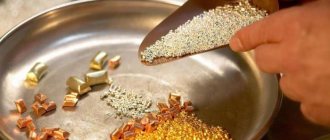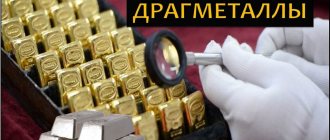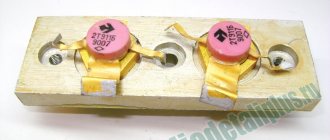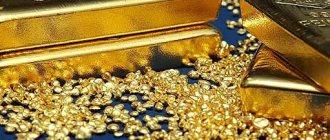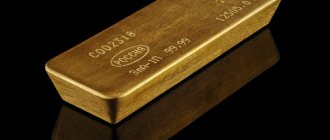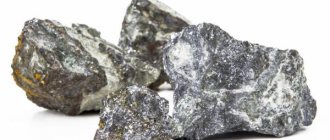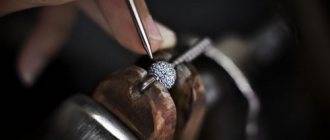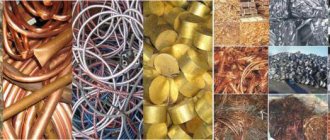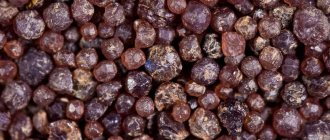Post updated: May 27, 2020
The use and development of the gold mineral resource base is determined by the development of the international financial system. Over the past three decades, the consumption of gold for industrial needs has tripled, and the areas of application have expanded many times. It is for this reason that many are interested in how to extract gold from old electronics.
What are the precious metals?
The list of precious metals will not take up much space - there are eight of them. At the same time, let’s remember chemistry and the designations of precious metals:
- gold, Aurum - Au (lat. Aurum), stock code - XAU;
- silver, argentum - Ag (lat. Argentum), stock symbol - XAG;
- platinum, platinum - Pt (lat. Platinum), in XPT quotes;
platinum group metals:
- palladium, palladium - Pd (lat. Palladium), exchange code - XPD;
- iridium, iridium - Ir (lat. Iridium);
- rhodium, rhodium - Rh (lat. Rhodium);
- ruthenium, ruthenium - Ru (lat. Ruthenium);
- osmium, osmium - Os (lat. Osmium).
These are all types of precious metals.
Jewelry metals of these metals are gold, silver, platinum and (more recently) rhodium. Rhodium is not used to make full-fledged jewelry frames. The metal is too expensive and too difficult to process. The surface of jewelry alloys is covered with the thinnest layer of rhodium.
Where exactly is gold used?
Precious metal may be present in the following parts:
- contacts of processors and controllers;
- pins of expansion cards and motherboards;
- hard drive connectors;
- bus contacts (AGP, IDE, PCI);
- headphone plugs and pins of professional sound cards.
Important! The percentage of metal content is minimal; it can be detected by the yellow color of the indicated elements. In budget devices, gold may be absent, as it is replaced by cheaper copper and aluminum.
Soviet-era equipment contains Au in the following components:
- ceramic chip leads (plastic cases may include a small amount) and crystal plates;
- capacitors for military radio stations and generators;
- substrate, external pad and contact terminals of transistors;
- radio tubes (on grids near the cathode);
- relay;
- pins and connectors.
Reference! In terms of gold content, the first place is occupied by capacitors (devices of the Ministry of Defense) and microcircuits.
Why are they valued?
Precious metals do not rust. These metals are “arrogant”. They, unlike many metals, do not like to communicate and “hang out” with other chemical elements. This preserves its original shine and beauty. Gold and silver have high ductility and good malleability.
The characteristics of precious metals are surprising:
- Gold is very malleable (1 gram of metal can be drawn into a wire 3 km long).
- Silver has the highest reflectivity (up to 95%).
- Platinum has excellent ductility and malleability - how could it not be used in jewelry.
- Rhodium has excellent reflectivity and hardness.
Precious metals are rare, have low annual production volumes, and have unique chemical properties. All this allows us to rightfully call these metals precious.
All precious metals are quite expensive, but... Their price is insignificant in comparison with the not at all noble Californian. It is the most expensive metal in the world.
Ore mining
Silver and gold have been known to people since ancient times. The reason is that precious metals are found in the form of nuggets, or more simply, pieces of pure metal.
We recommend: MERCURY - “dragon’s blood” in lamps and reactors
The extraction of these metals was carried out 4-5 thousand years ago, and they were mined in Asia, America, Europe, and Africa.
Behind the Golden Fleece
Those who have seen the film “The Argonauts” or read the myths of ancient Greece know about the voyage of the legendary heroes for the Golden Fleece. They sailed from Greece to distant Colchis (the same one in what is now Georgia). But we are wondering about the fleece - why it is golden. Fleece - lamb skin. Golden because there was golden sand on it.
There was such an ancient method of extracting gold, Strabo wrote about it in “Geography”:
“In their country (the territory of modern Georgia), as they say, mountain streams bring gold, and the barbarians catch it with sieves and shaggy skins. This is where, they say, the myth of the Golden Fleece arose.”
The skin was nailed to a plank tray and drowned in a river or stream that eroded the placer deposit. The sand got stuck in the wool, then the skin was dried, burned and gold bars were obtained.
Not verified: those who wish can still try to pan for gold in this way, as one (at least) tourist resource claims.
From ore to ingot
Mining precious metals is a labor-intensive process. Gold reserves are decreasing, many are in hard-to-reach places, “under revision.” Companies mining precious metals are constantly improving their mining technology.
There are no easy deposits.
Let's go from a gold-bearing rock to a ring on a woman's finger.
Primary ore mining occurs in already explored deposits. Geologists spend time on expeditions, examine outcrops (rock outcrops), describe the collected samples, and observe whether there are any satellite minerals of noble metals. For silver, these are kerargyrite (silver hornblende), argentite, and proustite.
Before the revolution in the Urals, the “grandfathers-miners” were engaged in searching for gold veins. And they found veins.
The problem with Ural gold mining is water. Groundwater seeps through the walls, drips from the ceiling, and the floor is often flooded with water.
African and Indian gold mines suffer from the heat - it is above 40°C there.
Gold - to the surface
In places determined by geologists, pits are drilled, explosives are dropped into them and the rock is undermined. Then, using special equipment, the ore is delivered to the top and taken to the processing plant.
Extracting gold from ore
You look at the gold ore and pass by. She is not beautiful, she does not (usually) sparkle with gold. Let's start producing gold.
The content of precious metals in the ore dictates the method of processing.
There are several of them:
- Cyanidation.
- Heap leaching.
- Amalgamation.
- Hydrometallurgy.
We received a precious metal, not too pure. Go ahead.
Refining
To remove remaining impurities from gold, it is saturated with sulfur or chlorine. The essence of the process is to make gold liquid, then strain it, separate out impurities and convert it into a solid state.
We recommend: CESIUM - a metal with an explosive character
Casting
Where does the gold go now - in molds - cast iron molds, gold is poured into them. The metal hardens quickly, so it sparkles in the cradle mold. You've seen gold bars of this shape on TV.
What is refining?
The widespread use of gold in industry has also led to negative consequences: there are fans of extracting metal from old microcircuits, that is, carrying out refining.
Refining is the process of obtaining pure precious metals by releasing them from a mixture. This method of obtaining gold from old electronics is also available at home.
How to carry out this refining? In words, everything is quite simple. If you read the reviews, you can understand that everything is not entirely simple. First, you need to find out which microcircuits contain gold.
Quality, samples, stamps
Next is the way to the laboratory. A piece of gold is sent there, different instruments are used to check the purity, the amount of remaining impurities, and in general whether the gold is worthy of taking a place in the gold and foreign exchange fund, turning into jewelry, or going to work in space.
The chemists gave the go-ahead - the ingots are sent for branding.
Each ingot gets its own number. The ingot is marked with the manufacturer's mark and hallmark.
Bank bars should weigh 12 kg, but sometimes the weight varies from 11 to 13 kg.
How are precious metals branded?
There are several ways of branding:
- Mechanical. With a regular hammer or on machines.
- Electro-spark . The brand is burned out using a special device.
- Laser. Produced using a laser machine and stamp masks.
Where is the country's gold located?
Part of Russia's gold reserves lies in the Central Bank vault. They say that the storage facility is protected by several degrees of protection, and the security systems are the most modern. Who wants it, check it out. We definitely won't go there.
Some of the Russian gold lies in the USA, in the famous Fort Knox.
Types of samples for jewelry
There are three types of jewelry markings in Russia:
- spool;
- metric;
- carat
Spool - 4.26 grams. The pre-revolutionary spool measure was the number of spools in a pound of alloy.
In the metric system, the hallmark number indicates the amount of pure gold per 1000 grams of weight. That is, if the ring has a hallmark of 583, it means there are 583 grams of gold in it, and the rest is a ligature alloy.
Imported gold products are marked with the word “gold” . Now, knowing the markings, you can easily read the mark even on pre-revolutionary, antique products.
Where to find the stamp
You will find the real mark:
- at the ring - on the inside of the rim;
- for earrings, chains, brooches - with a lock;
- for pendants - on the inside of the ear.
Not just decorations
Gold and silver are the main metals for jewelry. Platinum too, but that's for the elite. And the rest of the precious metals, are their unusual properties really not used - the inquisitive will ask.
Also how they are used. Here is a list of areas of application of precious metals:
- Electrical engineering. It is impossible to imagine it without noble metals. Highly reliable contacts, including metal-ceramic; Communication (well, who lives without a telephone now) is impossible without precious metals.
- Laboratory technology, chemical engineering . Containers (from tiny to real boilers) that can resist aggressive acids; Platinum or its alloys with other precious metals cover the surfaces of equipment in the pharmaceutical and food industries. Interesting: the boiler, of course, is difficult to steal, but in Soviet times, when using a crucible (cup) made of platinum in the laboratory, you had to sign in a special journal - when you took it, when you returned it. The dishes made of precious metals themselves were stored in safes.
- Medicine. Those who were treated with lapis, protargol, know that you were treated with silver preparations. There are diseases for which gold solutions are prescribed. Radioactive gold needles are used in the treatment of cancer.
- Protective coatings . Precious metals are used in the space industry. A very thin layer of gold is applied to the outer surface of the satellites (increasing reflectivity, protecting against corrosion).
- Some noble metals (silver, gold, platinum) work successfully as catalysts in the oil and chemical industries.
- Everyone has heard about gold and foreign exchange reserves. This is where the state’s “rainy day reserve” lies. This is mainly gold, silver is used in much smaller quantities.
- Coins made of precious metals have been known for a long time. Nowadays such coins are mainly of collector's or investment interest.
- Let's not forget about the jewelry industry. The pure shine of silver, the languid shimmer of gold - this is for us, our loved ones. It is a rare woman who can imagine herself without jewelry made of precious stones and metals. For your beloved (and very wealthy husband), you can buy a fountain pen as a gift, where the nib is made of an alloy of osmium, platinum and iridium.
We recommend: NIOBIUM - myths and reality
There are many areas of use of precious metals. Don't consider them lazy aristocrats, incapable of anything serious.
How is precious metals selected when processing equipment and instruments?
To separate precious metals from transistors, microcircuits, circuit boards and other small and large parts, we use special chemicals. Thus, in our activities we widely use mercury, nitric and sulfuric acid. Thanks to them, at our collection point for radio components, we are able to obtain precious metals from products you no longer need and use them further for their intended purpose.
Through proper disposal and recycling of equipment, we can return valuable metals to circulation and reduce the final cost of finished products in which they are used.
Now you know where to donate radio components and other devices in order to get good money for it and help us in the manufacture of new high-quality products from precious metals!
